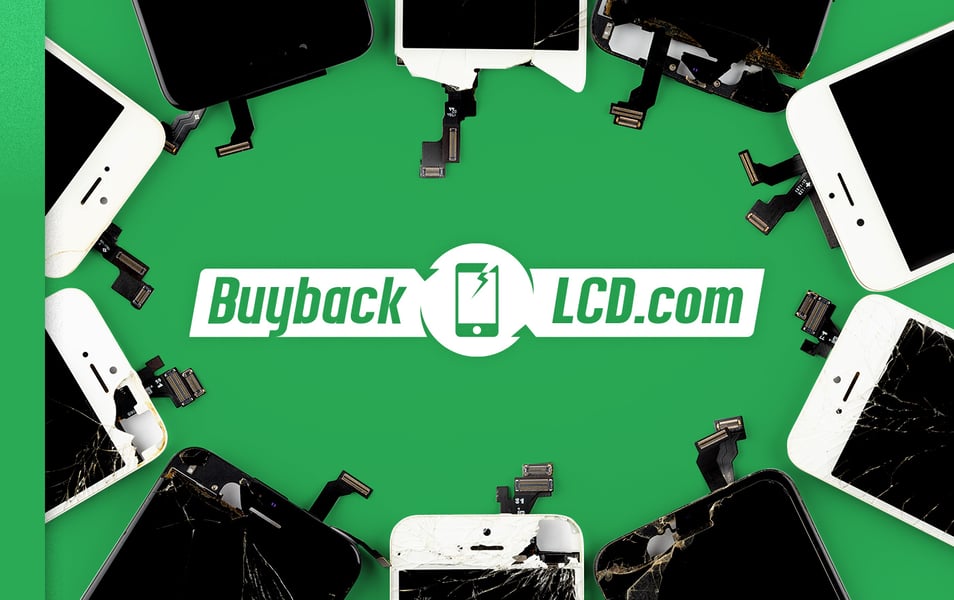From Buyback to a Refurbished display, the process.

Do you have a bunch of busted screens where the LCD still works? All around the world, broken screens are bought up by various 'Buyback' suppliers. These busted LCDs serve as the raw materials for refurbished screens. But what exactly is the journey of a busted screen? In this blog, we'll walk you through the process from Buyback to Refurbished screens and explain the different quality grades in the market.
The Journey of a Busted Smartphone Screen
Most of the screens that are bought up are initially shipped to Hong Kong. From there, they're resold to Chinese traders who have their own shops in the electronics market of Shenzhen. These Chinese traders then transport the screens to Shenzhen.
In Shenzhen, the broken screens are bought up by manufacturers specialized in refurbishment. In the factories, new glass panels are placed on the LCDs, and if needed, the backlight and polarizer are replaced. Once the screens are repaired, the refurbished screens are sold again to Chinese traders with shops in the electronics market of Shenzhen.
OEM Refurbished LCDs with Desired Materials
Our sourcing team in Shenzhen purchases custom-made OEM Refurbished LCDs with the desired materials. These materials are handpicked by our specialists and then offered to manufacturers who assemble the screens. Additionally, we have supply from our own Buyback program (BuybackLCD.com). We're very strict about the quality of donors we purchase because it largely determines the eventual quality of the OEM refurbished display. The screens from our own Buyback program that don't meet our quality standards are still bought but not used for our own OEM refurbished quality. Instead, we simply sell these screens in China.
For each specific iPhone series, our team in China knows very well which factory specializes in refurbishing which model. Some factories, for example, excel in the 8 series while others specialize in the X series. We make distinctions in our choice of factory based on this. We supply the donors there, pay a refurbishment fee, and receive the OEM refurbished displays back after a double test by our own inspectors. These screens are then shipped to our warehouse in the Netherlands and are ready for sale!
Screen Quality Grades
When someone purchases refurbished screens, they'll first determine the grade of a screen. In China, there are five different quality grades, and the price varies accordingly. Naturally, the end-user wouldn't want to pay the same price for an LCD with dead pixels as they would for a perfectly working screen. The worse the cosmetic damage, the less consumers are willing to pay for the screen, thus the price of a Buyback screen is derived from this. Therefore, the same grading system is used for both the Buyback and the OEM refurbished screens.
Below, you can see the differences between our grades:
- A/B Grade: No or minor imperfections on LCD or backlight. This includes: No or minor imperfections on LCD backlight. This includes: 1-2 spots, max 0.2mm, and/or screens with slight signs of aging. Light burn-in.
- C Grade: LCDs that still work but have more than 1-2 minor imperfections in the backlight (this includes light pressure damage). Medium or heavy signs of aging. Medium or heavy burn-in.
Different models may have specific variations. For OLED screens for the iPhone X series, for instance, extra attention is paid to the severity of screen breaks. If the screen is severely broken, the LCD (soft-OLED) can crumple, and the touch function may fail after refurbishment.
Hidden Defects Aren't Always Detected
During the refurbishment process, some screens inevitably break. There isn't a single manufacturer on the market that can make all A-grade Buyback screens perfect. This is because during inspections, some hidden defects may not be detected. Think of dead pixels under a crack that only become visible after refurbishment. Sometimes, dirt may also get between the glass or polarizer during the refurbishment process. Typically, a manufacturer can produce between 50 to 60 percent of the purchased genuine A-grade Buyback screens.
Pricing of Buyback and OEM Refurbished Screens
In addition to grading, prices are also based on supply and demand. If demand exceeds supply, prices will rise. However, the demand for OEM refurbished screens has decreased due to the arrival of China copies. Consequently, the price you get for a Buyback screen also decreases.
The selling price for refurbished screens is determined by three factors:
- Purchase price of the Buyback screen;
- Purchase price of materials (such as glass, backlight, and polarizer);
- Failure rate during the buyer's inspections.
Are you looking for a solid partner to buy broken displays? BuybackLCD.com, a service of Mobileparts, guarantees fair prices and a smooth process for handling and payment.

